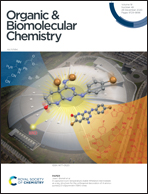|
Autors/es
Galve, Iñaki ; Ondoño, Raül ; Ondoño, Raül ; de Rocafiguera, Claudi ; de Rocafiguera, Claudi ; Puig de la Bellacasa, Raimon ; Puig de la Bellacasa, Raimon ; Batllori, Xavier ; Batllori, Xavier ; Puigjaner, Cristina; Font-Bardia, Mercè; Vallcorba, Oriol; Teixidó, Jordi ; Puigjaner, Cristina; Font-Bardia, Mercè; Vallcorba, Oriol; Teixidó, Jordi ; Borrell, José I. ; Borrell, José I.
|
Abstract
Wheland intermediates are usually unstable compounds and only a few have been isolated at very low temperatures. During our work on tyrosine kinase inhibitors, we studied the bromination of 7 in order to obtain a dibromo substituted pyrido[2,3-d]pyrimidin-7(8H)-one which could be orthogonally decorated. Surprisingly, treatment of 7 with 3 equiv. of Br2 in acetic acid (AcOH) afforded 12, a captured room temperature stable Wheland bromination intermediate stabilized by the bromination of the imino tautomer of the amino group at C4 of the pyridopyrimidine skeleton. The structure was confirmed by crystal structure determination from powder X-ray diffraction data. Treatment of 12 with DMSO afforded the dibromo substituted compound 13 presenting a bromine atom at C6 and C5–C6 unsaturation. 13 was directly accessed by treating 7 with N-bromosuccinimide (NBS), a protocol extended to other compounds using NBS or N-iodosuccinimide (NIS) to afford 6-halo substituted systems. 26, bearing an iodine at C6 and a p-bromophenylamino at C2, allows the orthogonal decoration of pyridopyrimidines.
|

WoS
Scopus
Altmetrics
 
|
|
Publicació
Organic & Biomolecular Chemistry, 2020, v.18, n.48, p.9810-9815
|
